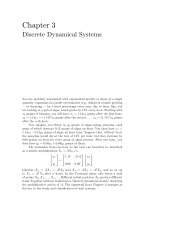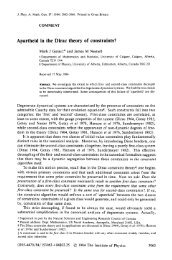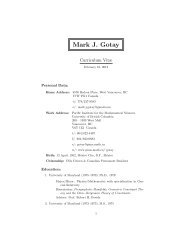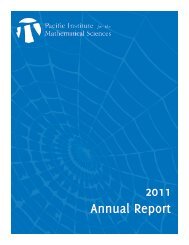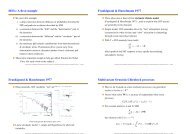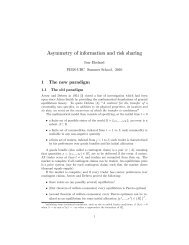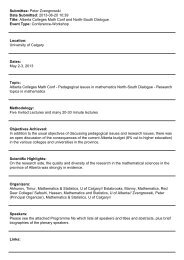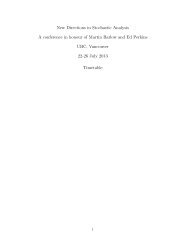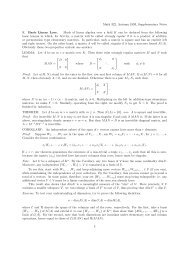41 PRIMA 2013 AbstractsOsamu SaekiKyushu University, Japansaeki@imi.kyushu-u.ac.jpA broken Lefschetz fibr<strong>at</strong>ion (BLF, for short) is a smoothmap of a closed oriented 4-manifold onto a closed surfacewhose singularities consist of Lefschetz critical points(w.r.t. local complex coordin<strong>at</strong>es comp<strong>at</strong>ible with theorient<strong>at</strong>ions) together with indefinite folds. Such aclass of maps was first introduced by Auroux-Donaldson-K<strong>at</strong>zarkov in rel<strong>at</strong>ion to near-symplectic structures, andnow it is known th<strong>at</strong> every closed oriented 4-manifold admitsa BLF over the 2-sphere. In this talk, we give aset of explicit moves for BLFs which can connect any twohomotopic BLFs, and give an elementary and constructiveproof to the fact th<strong>at</strong> any map into the 2-sphere ishomotopic to a BLF whose indefinite fold has embeddedimage. This is a joint work with R. İnanç Baykur (MaxPlanck Institute for M<strong>at</strong>hem<strong>at</strong>ics).Geometry of non-tame polynomial mapsKiyoshi TakeuchiUniversity of Tsukuba, Japantakemicro@nifty.comFor a polynomial map f = (f 1 , . . . , f k ): C n −→ C k (1 ≤k ≤ n), it is well-known th<strong>at</strong> there exists a proper subsetB ⊂ C k such th<strong>at</strong> the restrictionC n \ f −1 (B) −→ C k \ B (5)of f is a locally trivial fibr<strong>at</strong>ion. We denote by B f thesmallest subset B ⊂ C k s<strong>at</strong>isfying this condition. Theelements of B f are called bifurc<strong>at</strong>ion points of f. Whenk = 1 many m<strong>at</strong>hem<strong>at</strong>icians obtained various subsets ofC k = C containing B f . In particular, Némethi and Zaharia[8] showed th<strong>at</strong> for a non-convenient polynomialf = (f 1 ) such a subset is obtained by the bad faces of itsNewton polyhedron <strong>at</strong> infinity Γ ∞(f). In this talk, wefirst introduce the following analogue of their result forgeneral k ≥ 1 (see also Nguyen [9] for a rel<strong>at</strong>ed result).Theorem: (Chen-Dias-T-Tibăr [2]) Assume th<strong>at</strong> f =(f 1 , . . . , f k ): C n −→ C k is non-degener<strong>at</strong>e <strong>at</strong> infinity.Let N f , K f ⊂ C k be the subsets of C k defined by theNewton polyhedra <strong>at</strong> infinity of f 1 , . . . , f k in [2]. Thenwe haveB f ⊂ f(singf) ∪ N f ∪ K f . (6)Note th<strong>at</strong> if k = 1 this result coincides with th<strong>at</strong> of [8].When k = 1 and n = 2, Némethi and Zaharia [8] provedthe equality B f = f(singf)∪N f ∪K f and conjectured itsvalidity also in the higher-dimensional case n ≥ 3. In thistalk, we next introduce our approach to this conjecture.By using the results in [5] we will show th<strong>at</strong> it can beverified in many cases. Finally, we restrict ourselves to thecase k = 1. If f = (f 1 ) is convenient and non-degener<strong>at</strong>e<strong>at</strong> infinity, then by a result of Broughton [1] we have thecohomological concentr<strong>at</strong>ionH j (f −1 (R); C) = 0 (j ≠ 0, n − 1) (7)for the generic fiber f −1 (R) (R ≫ 0) of f. However,many polynomials th<strong>at</strong> we usually encounter are not convenient.They are not tame <strong>at</strong> infinity. The study ofnon-tame polynomials is important also for the Jacobianconjecture since they are the only interesting objects for it(see [2] etc.). The main reason why non-tame polynomialscould not be studied successfully before is th<strong>at</strong> one cannotexpect to have the cohomological concentr<strong>at</strong>ion for them.Here we partially overcome this difficulty on non-tamepolynomials by improving the above-mentioned result ofBroughton [1] as follows. Let C R = {x ∈ C | |x| = R}(R ≫ 0) be a sufficiently large circle in C such th<strong>at</strong>B f ⊂ {x ∈ C | |x| < R}. Then by restricting thelocally trivial fibr<strong>at</strong>ion C n \ f −1 (B f ) −→ C \ B f toC R we obtain a geometric monodromy automorphismΦ ∞ f : f −1 (R) ≃ f −1 (R) and the linear mapsΦ ∞ j : Hj (f −1 (R); C) ≃ H j (f −1 (R); C) (j = 0, 1, . . .)(8)associ<strong>at</strong>ed to it. We call Φ ∞ j ’s the (cohomological) monodromies<strong>at</strong> infinity of f. Recently in [10], by using theNewton polyhedron <strong>at</strong> infinity Γ ∞(f) of f we defined afinite subset A f ⊂ C of “bad" eigenvalues which we call<strong>at</strong>ypical engenvalues of f. Then we have the following refinementof the main result of Broughton [1]. For λ ∈ Cand j ∈ Z let H j (f −1 (R); C) λ ⊂ H j (f −1 (R); C) be thegeneralized eigenspace for the eigenvalue λ of the monodromy<strong>at</strong> infinity Φ ∞ j .Theorem: (T-Tibăr [10]) Let f ∈ C[x 1 , . . . , x n] be anon-convenient polynomial such th<strong>at</strong> dim Γ ∞(f) = n.Assume th<strong>at</strong> f is non-degener<strong>at</strong>e <strong>at</strong> infinity. Then forany non-<strong>at</strong>ypical eigenvalue λ /∈ A f of f we have theconcentr<strong>at</strong>ionH j (f −1 (R); C) λ ≃ 0 (j ≠ n − 1) (9)for the generic fiber f −1 (R) ⊂ C n (R ≫ 0) of f.With this theorem <strong>at</strong> hand, we can extend the results in[4], [6] and [7] etc. to non-convenient polynomials. Inparticular, as in [7] and [3] by using the motivic Milnorfiber <strong>at</strong> infinity of f we completely determine the Jordannormal forms of Φ ∞ n−1 for non-<strong>at</strong>ypical eigenvalues λ /∈A f of f. See [10] for the details.[1] Broughton, S. A. “Milnor numbers and the topologyof polynomial hypersurfaces", Invent. M<strong>at</strong>h., 92 (1988):217-241.[2] Chen, Y., Dias, R., Takeuchi, K. and Tibăr,M. “Invertible polynomial mappings via Newton nondegeneracy",arXiv:1303.6879.[3] Esterov, A. and Takeuchi, K. “Motivic Milnor fibersover complete intersection varieties and their virtual Bettinumbers", Int. M<strong>at</strong>h. Res. Not., Vol. 2012, No. 15(2012): 3567-3613.[4] Libgober, A. and Sperber, S. “On the zeta functionof monodromy of a polynomial map", Compositio M<strong>at</strong>h.,95 (1995): 287-307.[5] M<strong>at</strong>sui, Y. and Takeuchi, K. “Milnor fibers oversingular toric varieties and nearby cycle sheaves", TohokuM<strong>at</strong>h. J., 63 (2011): 113-136.[6] M<strong>at</strong>sui, Y. and Takeuchi, K. “Monodromy zetafunctions <strong>at</strong> infinity, Newton polyhedra and constructiblesheaves", M<strong>at</strong>hem<strong>at</strong>ische Zeitschrift, 268 (2011): 409-439.[7] M<strong>at</strong>sui, Y. and Takeuchi, K. “Monodromy <strong>at</strong> infinityof polynomial maps and Newton polyhedra, withAppendix by C. Sabbah", Int. M<strong>at</strong>h. Res. Not., Vol.2013, No. 8 (2013): 1691-1746.[8] Némethi, A. and Zaharia, A. “On the bifurc<strong>at</strong>ion setof a polynomial function and Newton boundary", Publ.Res. Inst. M<strong>at</strong>h. Sci., 26 (1990): 681-689.[9] Nguyen, T. T., “Bifirc<strong>at</strong>ion set, M-tameness,asymptotic critical values and Newton polyhedrons",arXiv:1205.0939v5, to appear in Kodai M<strong>at</strong>h. J.[10] Takeuchi, K. and Tibăr, M. “Monodromies <strong>at</strong> infinityof non-tame polynomials", arXiv:1208.4584.Characteristic points, fundamental cubicform and Euler characteristic of projectivesurfacesRicardo Uribe-VargasUniversité de Bourgogne, Francer.uribe-vargas@u-bourgogne.fr
42 PRIMA 2013 AbstractsJoint work with M. Kazarian. Generic surfaces in projective3-space have isol<strong>at</strong>ed characteristic points (invariantunder projective trasform<strong>at</strong>ions and stable under smallperturb<strong>at</strong>ions of the surface) called elliptic nodes, hyperbolicnodes and godrons (also known as cusps of Gauss).These characteristic points have interesting propertiesand deserve special <strong>at</strong>tention. We give a geometric definitionof the characteristic points (there are several equivalentdefinitions) and we define n<strong>at</strong>ural local invariants forthem (a sign ±).Our formulas for global counting of these invariants onthe surface (or on domains in it) involve the Euler characteristicof the surface (or of the respective domains)providing restrictions on the coexistence of characteristicpoints.One way to prove our counting formulas (we know threeways) is considering the fundamental cubic form: in thesame way as the second fundamental quadr<strong>at</strong>ic form measuresthe quadr<strong>at</strong>ic devi<strong>at</strong>ion of a surface from its tangentplane, the cubic fundamental form measures the cubic devi<strong>at</strong>ionof the surface from its quadr<strong>at</strong>ic part. The fundamentalcubic form is a local intrinsic invariant definedfor every point of the surface, which vanish <strong>at</strong> the characteristicpoints.Our exposition will be r<strong>at</strong>her geometrical and for a wideaudience.Topological classific<strong>at</strong>ion of multiaxial U(n)-actionsMin Yan (joint with S. Cappell and S. Weinberger)Hong Kong University of Science and Technology, HongKong, Chinamamyan@ust.hkA manifold under the action of the unitary group U(n)is multiaxial if all the isotropy groups are unitary subgroups.Such manifolds are often modeled on kC n ⊕ jR,where C n has the canonical U(n)-action and R has trivialU(n)-action. One of the major achievements aboutmultiaxial manifolds was M. Davis and W.C. Hsiang’sconcordance classific<strong>at</strong>ion in l<strong>at</strong>e 1970s for the smoothc<strong>at</strong>egory and under the assumption k ≤ n.We study the structure set S U(n) (M) of a multiaxialU(n)-manifold M, which is the homeomorphism classesof the topological U(n)-manifolds equivariantly homotopyequivalent to M. We show th<strong>at</strong> S U(n) (M) can be decomposedinto simpler structure sets. We discuss the implic<strong>at</strong>ionof the decomposition and compute explicitly for thecase M is the canonical represent<strong>at</strong>ion sphere. All theresults do not assume k ≤ n.Milnor fibers of real line arrangementsMasahiko YoshinagaHokkaido University, Japanyoshinaga@m<strong>at</strong>h.sci.hokudai.ac.jpThe Milnor fiber of a line arrangement is a certain cycliccovering space of the complexified complement equippedwith monodromy action. We will discuss the monodromyaction on the first homology group. We will present anew algorithm computing multiplicities of monodromyeigenvalues, which uses real and combin<strong>at</strong>orial structures(chambers). I will also give an upper bounds and severalconjectures.Special Session 21Symplectic Geometry and Hamiltonian DynamicsContacting the moonUrs FrauenfelderSeoul N<strong>at</strong>ional University, Koreafrauenf@snu.ac.krThe restricted three body problem has an intriguing dynamics.In joint work with Peter Albers, Gabriel P<strong>at</strong>ernainand Otto van Koert we showed th<strong>at</strong> below andslightly the first critical level energy hypersurfaces ofthe restricted three body problem are of contact type.This result allows us to apply global methods comingfrom Gromov-Witten theory, Floer theory, and SymplecticField theory to this old problem. I will explain howwe can use these global methods to detect global surfacesof section were the perturb<strong>at</strong>ive methods used so far fail.Mean Euler characteristic:caseViktor L. GinzburgUniversity of California, Santa Cruz, USAginzburg@ucsc.eduthe degener<strong>at</strong>eThe mean Euler characteristic (MEC) is an invariant ofa contact manifold, which is on the one hand sensitiveenough to distinguish interesting contact structures and,on the other, rel<strong>at</strong>ively easily computable in terms of thedynamics of the Reeb flow. This invariant was introducedby van Koert. As has been shown by Kerman and thespeaker, the MEC can be expressed in terms of local,purely topological, invariants of closed Reeb orbits wheneverthe Reeb flow is non-degener<strong>at</strong>e and has finitely ofsuch orbits. This expression generalizes the resonancerel<strong>at</strong>ion for the mean indices of closed characteristics establishedby Viterbo for convex hypersurfaces, and it hasbeen further refined and generalized by Espina.In this talk, based on a joint work with Yusuf Goren, wewill discuss a version of such a local formula for the MECwhen the closed orbits are degener<strong>at</strong>e. This work buildson the previous results of Long et al. and Hryniewicz andMacarini, and its main new fe<strong>at</strong>ure is th<strong>at</strong>, as in the nondegener<strong>at</strong>ecase, the contributions of individual orbits arepurely topological. We will also touch upon applic<strong>at</strong>ionsof this resonance rel<strong>at</strong>ion to dynamics.The Hill-type formula and Krein-type traceformulaXijun HuShandong University, Chinaxjhu@sdu.edu.cnIn the study of the motion of lunar perigee, Hill got a formulawhich rel<strong>at</strong>es the characteristic polynomial of themonodromy m<strong>at</strong>rix for a periodic orbit and a kind of infinitedeterminant. Hill’s formula is useful in understandingthe property of the monodromy m<strong>at</strong>rix. Motiv<strong>at</strong>edby the previous works, we build up the Hill-type formulafor S-periodic solutions for first-order ordinary differentialequ<strong>at</strong>ions and Lagrangian systems. The S-periodic solutionis a solution such th<strong>at</strong> x(t) = Sx(t + T ) for some orthogonalm<strong>at</strong>rix S, which comes n<strong>at</strong>urally from the studyof symmetry periodic orbits in n-body problem. Basedon it, we get the Trace formula for linear ODE, includethe case of standard Sturm-Liouville systems, which canbe consider as a generaliz<strong>at</strong>ion of Krein’s work in 1950’s.Especially, for the eigenvalue problem Lu + λR(x)u = 0,where L is the Sturm-Liouville oper<strong>at</strong>or, ∑ 1/λ k j can becomputed by the trace formula. Some applic<strong>at</strong>ions forthe stability problem is given.The extremal Kahler metrics on toric manifoldsAn-Min LiSichuan University, Chinam<strong>at</strong>h_li@yahoo.com.cnWe study the prescribed scaler curv<strong>at</strong>ure problem on toricmanifolds, following Donaldson’s program. Let ∆ be an
- Page 2 and 3:
1PRIMA 2013-Table of ContentsTable
- Page 4 and 5:
3PRIMA 2013-OrganizationOrganizatio
- Page 6 and 7:
5PRIMA 2013-OrganizationYoshikazu G
- Page 8 and 9:
7PRIMA 2013-Useful InformationUsefu
- Page 10 and 11:
9PRIMA 2013-Useful InformationTaxi:
- Page 12 and 13:
11PRIMA 2013-Useful Informationmath
- Page 14 and 15:
13PRIMA 2013 Program-Schedule-at-a-
- Page 16 and 17:
15PRIMA 2013 Program-Monday, June 2
- Page 18 and 19:
17PRIMA 2013 Program-Monday, June 2
- Page 20 and 21:
19PRIMA 2013 Program-Monday, June 2
- Page 22 and 23:
21PRIMA 2013 Program-Monday, June 2
- Page 24 and 25:
23PRIMA 2013 Program-Tuesday, June
- Page 26 and 27:
25PRIMA 2013 Program-Tuesday, June
- Page 29 and 30:
28PRIMA 2013 Program-Tuesday, June
- Page 31 and 32:
30PRIMA 2013 Program-Tuesday, June
- Page 33 and 34:
32PRIMA 2013 Program-Wednesday, Jun
- Page 35 and 36:
34PRIMA 2013 Program- Thursday, Jun
- Page 37 and 38: 36PRIMA 2013 Program- Thursday, Jun
- Page 39 and 40: 38PRIMA 2013 Program- Thursday, Jun
- Page 41 and 42: 40PRIMA 2013 Program- Thursday, Jun
- Page 43 and 44: 42PRIMA 2013 Program- Friday, June
- Page 45 and 46: 44PRIMA 2013 Program- Friday, June
- Page 48 and 49: 1 PRIMA 2013 AbstractsContents1 Pub
- Page 50 and 51: 3 PRIMA 2013 Abstractsof subfactors
- Page 52 and 53: 5 PRIMA 2013 AbstractsprocessesXu S
- Page 54 and 55: 7 PRIMA 2013 AbstractsIn this talk
- Page 56 and 57: 9 PRIMA 2013 Abstractsindependently
- Page 58 and 59: 11 PRIMA 2013 AbstractsEnumerating,
- Page 60 and 61: 13 PRIMA 2013 AbstractsRyuhei Uehar
- Page 62 and 63: 15 PRIMA 2013 AbstractsIn this talk
- Page 64 and 65: 17 PRIMA 2013 AbstractsSpecial Sess
- Page 66 and 67: 19 PRIMA 2013 Abstractscritical slo
- Page 68 and 69: 21 PRIMA 2013 AbstractsSpecial Sess
- Page 70 and 71: 23 PRIMA 2013 Abstractsstrictly awa
- Page 72 and 73: 25 PRIMA 2013 AbstractsPedram Hekma
- Page 74 and 75: 27 PRIMA 2013 Abstractsis well-know
- Page 76 and 77: 29 PRIMA 2013 Abstractssolid substr
- Page 78 and 79: 31 PRIMA 2013 AbstractsRapoport-Zin
- Page 80 and 81: 33 PRIMA 2013 Abstractssense. Our a
- Page 82 and 83: 35 PRIMA 2013 AbstractsIn an econom
- Page 84 and 85: 37 PRIMA 2013 AbstractsKyoto Univer
- Page 86 and 87: 39 PRIMA 2013 AbstractsAlexander Mo
- Page 90 and 91: 43 PRIMA 2013 Abstractsopen Delzant
- Page 92 and 93: 45 PRIMA 2013 AbstractsJian ZhouTsi
- Page 94 and 95: 47 PRIMA 2013 AbstractsJiaqun WeiNa
- Page 96 and 97: 49 PRIMA 2013 Abstractsthe end of 2
- Page 98 and 99: 51 PRIMA 2013 AbstractsJongyook Par
- Page 100 and 101: 53 PRIMA 2013 AbstractsPancyclicity
- Page 102 and 103: 55 PRIMA 2013 AbstractsEfficient nu
- Page 104 and 105: 57 PRIMA 2013 Abstractsand fountain
- Page 106: 59 PRIMA 2013 Abstractsformula esti



